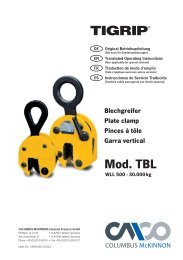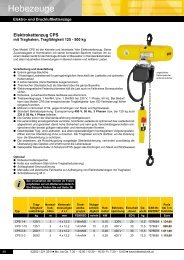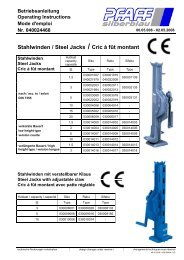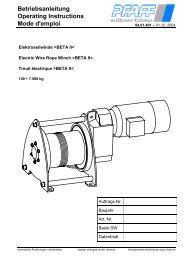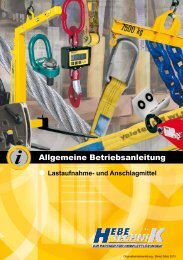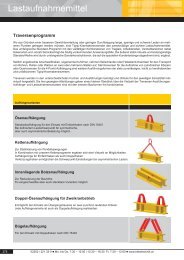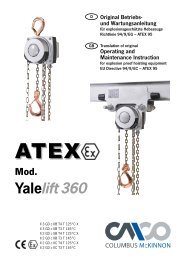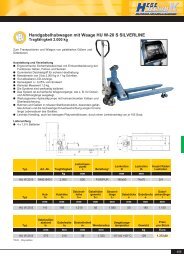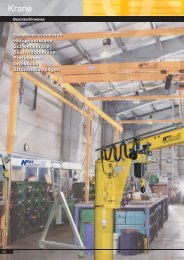Bedienungsanleitung Model YBF
Bedienungsanleitung Model YBF
Bedienungsanleitung Model YBF
Erfolgreiche ePaper selbst erstellen
Machen Sie aus Ihren PDF Publikationen ein blätterbares Flipbook mit unserer einzigartigen Google optimierten e-Paper Software.
DGBOriginal Betriebsanleitung(Gilt auch für Sonderausführungen)Translated Operating Instructions(Also applicable for special versions)Mod. <strong>YBF</strong>WLL 4,5 - 100 kgMod. <strong>YBF</strong>-LWLL 4,5 - 70 kgColumbus McKinnon Industrial Products GmbHPostfach 10 13 24 • D-42513 Velbert, GermanyAm Lindenkamp 31 • D-42549 Velbert, GermanyPhone +49 (0) 20 51/600-0 • Fax +49 (0) 2051/600-127Ident.-No.: 09901077/07.2011
DeutschVorwortDiese Betriebsanleitung ist von jedem Bedienervor der ersten Inbetriebnahme sorgfältigzu lesen. Sie soll helfen, das Produkt kennenzulernenund dessen bestimmungsgemäßeEinsatzmöglichkeiten zu nutzen.Die Betriebsanleitung enthält wichtige Hinweise,um das Produkt sicher, sachgerecht undwirtschaftlich zu betreiben. Ihre Beachtunghilft Gefahren zu vermeiden, Reparaturkostenund Ausfallzeiten zu vermindern und die Zuverlässigkeitund Lebensdauer des Produkteszu erhöhen. Diese Betriebsanleitung mussständig am Einsatzort des Produktes verfügbarsein. Neben der Betriebsanleitung und den imVerwenderland und an der Einsatzstelle geltendenverbindlichen Regelungen zur Unfallverhütungsvorschriftsind auch die anerkanntenRegeln für sicherheits- und fachgerechtesArbeiten zu beachten. Der Betreiber ist fürdie sach- und fachgerechte Unterweisung desBedienpersonals verantwortlich.Bestimmungsgemässe Verwendung- Das Gerät ist zum Handling von konstantenLasten wie Werkzeugen geeignet.- Die auf dem Gerät angegebene Tragfähigkeit(WLL) ist die maximale Last, die angeschlagenwerden darf.- Der Aufenthalt unter einer angehobenen Lastist verboten.- Der Bediener darf eine Lastbewegung erstdann einleiten, wenn er sich davon überzeugthat, dass die Last richtig angeschlagen istund sich keine Personen im Gefahrenbereichaufhalten.- Beim Einhängen des Gerätes ist vomBediener darauf zu achten, dass das Gerätso bedient werden kann, dass der Bedienerweder durch das Gerät selbst noch durchdie Last gefährdet wird.- Das Gerät kann in einer Umgebungstemperaturzwischen -10° C und +50° C eingesetztwerden. Bei Extrembedingungen solltemit dem Hersteller Rücksprache genommenwerden.- Vor dem Einsatz des Lastaufnahmemittelsin besonderen Atmosphären (hohe Feuchtigkeit,salzig, ätzend, basisch) oder der2DGBSeite 2Page 5DHandhabung gefährlicher Güter (z.B. feuerflüssigeMassen, radioaktive Materialien) istmit dem Hersteller Rücksprache zu halten.- Bei Funktionsstörungen ist das Gerät sofortaußer Betrieb zu setzen.- Soll das Gerät im Lebensmittelbereicheingesetzt werden, ist mit dem HerstellerRücksprache zu halten.- Balancer mit Schweißzangen sind wegenAbleitströmen isoliert aufzuhängen.- Die Aufhängung der Balancer ist so auszuführen,dass sie sich in Seilzugrichtungeinstellen können.Sachwidrige Verwendung- Die Tragfähigkeit (W L L) darf nicht überschrittenwerden.- Schweißarbeiten an Haken und Lastseilsind verboten. Das Lastseil darf nicht alsErdleitung bei Schweißarbeiten verwendetwerden (Fig. 1).- Schrägzug, d.h. seitliche Belastung auf dasGehäuse ist verboten (Fig. 2).- Die Benutzung des Gerätes zum Transportvon Personen ist verboten (Fig. 3).- Das Entfernen der Sicherheitsbügel vonTrag- bzw. Lasthaken ist unzulässig (Fig. 4).- Hakenspitze nicht belasten (Fig. 5).- Das Seil nicht knoten oder mit Seilklemmen,Schrauben oder ähnlichem verkürzen oderverlängern (Fig. 6). Seile dürfen nichtinstandgesetzt werden. Das Seil nicht überKanten ziehen.- Das Gerät nicht aus großer Höhe fallenlassen. Es sollte immer sachgemäß auf demBoden abgelegt werden.- Das Gerät darf nicht in explosionsfähigerAtmosphäre eingesetzt werden.Prüfung vor der erstenInbetriebnahmeVor der ersten Inbetriebnahme ist das Geräteiner Prüfung durch eine befähigte Personzu unterziehen. Diese Prüfung besteht imWesentlichen aus einer Sicht- und Funktionsprüfung.Diese Prüfungen sollen sicherstellen,dass sich das Lastaufnahmemittel in einemsicheren Zustand befindet und gegebenenfallsMängel bzw. Schäden festgestellt und behobenwerden. Als befähigte Personen könnenz.B. die Wartungsmonteure des Herstellersoder Lieferanten angesehen werden. DerUnternehmer kann aber auch entsprechendausgebildetes Fachpersonal des eigenenBetriebes mit der Prüfung beauftragen.Prüfung vor ArbeitsbeginnVor jedem Arbeitsbeginn ist das Geräteinschließlich der Tragmittel, Ausrüstung undTragkonstruktion auf augenfällige Mängelund Fehler zu überprüfen. Weiterhin ist daskorrekte Einhängen des Gerätes und der Lastzu überprüfen. Dazu ist mit dem Gerät eineLast über eine kurze Distanz zu heben undwieder abzusenken.Überprüfung der oberen AufhängungDie zur Aufnahme des Gerätes vorgeseheneAufhängung muss auf Beschädigungen bzw.Verschleiß überprüft werden.Überprüfung des Trag- und LasthakensDer Trag- bzw. Lasthaken muss auf Risse,Verformungen, Beschädigungen, Abnutzungund Korrosionsnarben nach DIN 15405-1überprüft werden.Überprüfung GehäuseDas Gehäuse muss auf Risse, Verformungen,Beschädigungen, Abnutzung und Korrosionsnarbenüberprüft werden.Überprüfung SeilführungDie Seilführung ist auf Beschädigungen bzw.Verschleiß zu überprüfen.Überprüfung DrahtseilAus Sicherheitsgründen muss ein Drahtseilausgewechselt werden, wenn die Drahtbrüchein den Außenlitzen eine vorgegebeneAnzahl übersteigt. Das Drahtseil muss sofortausgewechselt werden, wenn eine Litze vollständiggebrochen, das Seil verformt, geknickt,gestaucht oder in irgendeiner anderen Weisebeschädigt oder verschlissen ist!Maßgebend für die Wartung und Prüfungdes Drahtseiles sind die DIN 15020 Blatt 2“Grundsätze für Seiltriebe, Überwachung undGebrauch”, die ISO 4309 „Richtlinie für dieÜberwachung und das Ablegen“ von Drahtseilensowie die gültigen nationalen und internationalenVorschriften des Betreiberlandes.Das Drahtseil muss ersetzt werden• wenn die Anzahl der sichtbaren Drahtbrücheeine bestimmte Anzahl überschreitet• wenn eine komplette Litze gebrochen ist• wenn das Drahtseil Aufwölbungen, Knicke,Quetschungen, bleibende Verformungen,Stauchungen, Nestbildung oder Anzeichenvon besonders schwerem Verschleiß zeigt• wenn das Seil Schaden durch Hitzeeinflußgenommen hat• wenn das Seil innen oder außen Korrosionzeigt• wenn das Seil auf Grund mangelnderSchmierung verschlissen ist
inBetriebnahme- Gemäss DIN 15112 muss ein zusätzlichesSicherungsseil bzw. eine Sicherungskette ander oberen Öse des Balancergehäuses (s.Fig. 6, Pos. 2) montiert werden. Nur somitist gewährleistet, dass bei einem Versagender oberen Aufhängung der Balancer mit derangehängten Traglast nicht abstürzen kannund somit umstehende Personen verletzenund den Balancer bzw. angehängtes Werkzeugzerstören kann. Die maximale Längedes Sicherungsseiles muss so gewählt sein,dass der eventuelle Fallweg des Balancersmax. 100 mm betragen kann (Fig. 7).- Den Balancer an einer geeigneten Aufhängemöglichkeitbefestigen. Diese muss derTraglast des Balancers und dem angehängtemWerkzeug entsprechen.Der Balancer darf sich durch eine Bewegungnicht selbständig aus dieser Befestigunglösen können.- Die obere Aufhängung überprüfen, ob siesich frei drehen kann.EINSTELLEN DER TRAGLASTAchtung! Vor dem Anbringen der Traglastüberprüfen, ob das Gesamtgewicht desanzuhängenden Werkzeuges incl. allerweiterer angehängten Bauteile die maximaleKapazität des Balancers nicht überschreitet.- Traglast anhängen und die Federspannungauf das entsprechende Gewicht einstellen.- Die Einstellung der Federspannung auf dieentsprechende Traglast erfolgt durch dieVerstellung des Schneckengetriebes aufder hinteren Seite des Balancers (s. Fig. 6/ Fig. 8). Zur Erhöhung der FederspannungVerstellschraube im Uhrzeigersinn drehen.Um die Federspannung zu reduzieren, dieVerstellschraube gegen den Uhrzeigersinndrehen. Zur einfacheren Einstellung befindetsich bei einigen Typen auf derVorderseite des Balancers eine Skala, aufwelcher die momentan eingestellte Traglastabgelesen werden kann (s. Fig. 6 / Fig. 9).Achtung! Eine Einstellung oberhalb desangegebenen Traglastbereiches kann zurZerstörung der Feder führen.- Um die angehängte Traglast wieder abzuhängen,das komplette Seil (34) von derSeiltrommel (33) aus dem Balancer ziehenund die Seiltrommel blockieren.Zum Blockieren die Arretierungsspange(11) anheben, den Blockierstift um 30° imUhrzeigersinn drehen und einrasten lassen(Fig. 6 / Fig. 8).Achtung! Vor jedem Abhängen der Traglastmuss das Seil durch Blockieren der Seiltrommelgesichert werden, um einen un-beabsichtigten Einzug des Seiles in denBalancer zu vermeiden (Fig. 8).WECHSEL DES FEDERPAKETES undDEMONTAGE (siehe Fig. 10)Achtung! Im Inneren des Balancers befindetsich ein Federpaket. Bei unsachgemäßerDemontage des Balancers kann sich die Federschlagartig ausrollen und zu schweren Verletzungenführen. Das Federpaket immer nurals komplette Einheit wechseln.a) Das komplette Seil (34) von der Seiltrommel(33) aus dem Balancer ziehenund zum Blockieren der Seiltrommel dieArretierungsspange (11) anheben, denBlockierstift um 30° im Uhrzeigersinndrehen und einrasten lassen (Fig. 6 / Fig.8).b) Die angehängte Traglast aus dem Lasthakenenfernen (42) und die Federspannungdurch Drehen der Verstellschraube(50) gegen den Uhrzeigersinn so weitverringern, bis keine Federspannung mehrvorhanden ist.c) Das Seil (34) von der Seiltrommel (33)durch Lösen der Schraube (47), die durchden seitlichen Schlitz im Gehäuse zugänglichist (Fig. 6, Pos. 12), entfernen.Das Wechseln des Seiles ohne Demontagedes Gehäuses ist nur bei den <strong>Model</strong>len <strong>YBF</strong>-09/15/22/30/40/50/60/70 möglich.Bei allen anderen <strong>Model</strong>len Punkt c) überspringenund mit Punkt d) fortfahren.d) Getriebewelle (50) und Druckscheibe (51)entfernen.e) Einstellskala (31) nach Lösen der Schraube(32) entfernen (modellabhängig).f) Die Madenschrauben (13) lösen und Verriegelungsbolzen(49) aus dem Gehäuse (1)demontieren.g) Die Schrauben (29) entfernen und denGehäusedeckel (48) abheben. Federpaket(18) zusammen mit Seiltrommel (33)und Antriebswelle (14) aus dem Gehäuseentnehmen.h) Antriebswelle (14) aus der Seiltrommel (33)pressen.i) Schrauben (22) lösen und das Federpaket(18) von der Seiltrommel (33) entfernen.MONTAGE DES FEDERPAKETES undZUSAMMENBAUa) Federpaket (18) auf der Seiltrommel (33)unter Verwendung der Schrauben (22) undder Federringe (23) befestigen.b) Antriebswelle (14) in die Seiltrommel (33)einpressen.c) Verriegelungsbolzen (49) im Grundgehäuse(1) befestigen.d) Einheit Seiltrommel (33), Federpaket (18)und Antriebswelle (14) in das Grundgehäuse(1) stecken.e) Gehäusedeckel (48) mit den Schrauben(29) und Federringen (30) am Grundgehäusebefestigen.f) Seil (34) auf der Seiltrommel (33) montierenund durch die Schraube (47) fixieren.g) Getriebewelle (50) mit Druckscheibe (51)im Gehäuse (1) befestigen.h) Balancer an einem geeigneten Aufhängepunktmontieren und die gewünschteTraglast am Lasthaken (42) montieren.Zunächst die tatsächlich angehängte Lastdurch Wiegen kontrollieren.i) Mit Hilfe der Schraube (32) die Einstellskala(31) gemäß der angehängten Lastbefestigen (modellabhängig).j) Gewünschte Federspannung einstellen.k) Seilschutz (52) montieren.SEILWECHSELohne Demontage des GehäusesBei folgenden Typen ist ein Seilwechsel ohneDemontage des Balancers möglich:<strong>YBF</strong>-09/15/22/30/40/50/60/70Die Vorgehensweise ist bei diesen Typenwie folgt:Achtung! Vor jedem Abhängen der Traglastund vor jedem Seilwechsel muss das Seildurch Blockieren der Seiltrommel gesichertwerden, um einen unbeabsichtigten Einzugdes Seiles in den Balancer zu vermeiden.a) Das Seil (34) auf die maximale Länge ausdem Balancer ziehen.b) Die Seiltrommel (33) durch Auf- undAbbewegen des Seiles so ausrichten, dassdurch den seitlichen Schlitz am Gehäuse(siehe Fig. 6, Pos. 12) das Seilende mit derArretierungsschraube sichtbar ist.c) Zum Blockieren der Seiltrommel dieArretierungsspange (11) anheben, denBlockierstift um 30° im Uhrzeigersinndrehen und einrasten lassen (Fig. 6 / Fig.8).d) Abhängen der Traglast vom Lasthaken.e) Lösen der Sicherungsschraube (47) undEntfernen des Seiles.f) Das neue Seil von unten in den Balancerso einführen, dass das Seil über dieSeiltrommel geführt ist. Das Seil soweiteinschieben, dass es durch den seitlichenSchlitz sichtbar ist.g) Seilende in die Seiltrommel stecken undmit der Sicherungsschraube (47) fixieren.h) Traglast wieder anhängen und die manuelleTrommelblockierung lösen (Fig. 8).3
SEILWECHSELmit Demontage des GehäusesBei den folgenden Typen ist ein Seilwechselnur mit einer Demontage des Balancersmöglich:<strong>YBF</strong>-85/100/09L/15L/22L/30L/40L/50L/60L/70LDie Vorgehensweise ist bei diesen Typenwie folgt:a) Das komplette Seil (34) von der Seiltrommel(33) aus dem Balancer ziehenund zum Blockieren der Seiltrommel dieArretierungsspange (11) anheben, denBlockierstift um 30° im Uhrzeigersinndrehen und einrasten lassen (Fig. 6 / Fig.8).b) Die angehängte Traglast aus dem Lasthakenenfernen (42) und die Federspannungdurch Drehen der Verstellschraube(50) gegen den Uhrzeigersinn so weitverringern, bis keine Federspannung mehrvorhanden ist.c) Getriebewelle (50) und Druckscheibe (51)entfernen.d) Einstellskala (31) nach Lösen der Schraube(32) entfernen (modellabhängig).e) Die Madenschrauben (13) lösen und Verriegelungsbolzen(49) aus dem Gehäuse (1)demontieren.f) Die Schrauben (29) entfernen und denGehäusedeckel (48) abheben. Federpaket(18) zusammen mit Seiltrommel (33)und Antriebswelle (14) aus dem Gehäuseentnehmen.g) Lösen der Sicherungsschraube (47) undEntfernen des Seiles.h) Das neue Seil von unten in die Seiltrommeldes Balancer einführen und dasSeilende mit der Sicherungsschraube(47) fixieren.Danach folgen Sie zur Montage des Balancersden Anweisungen unter„Montage des Federpaketes undZusammenbau“.FEHLERBEHEBUNGSollte sich das Seil nicht mehr ausziehenlassen, kann dies mehrere Gründe haben:1. Die manuelle Trommelblockierung istbetätigt (Fig. 8).- Zum Lösen der Trommelblockierung dieArretierungsspange (11) anheben, denBlockierstift (8) um 30° gegen den Uhrzeigersinndrehen und einrasten lassen(Fig. 6 / Fig. 8).2. Der Verriegelungsstift (24) des Federpaketeswurde ausgelöst, da die Federkraftdes Balancers unterhalb der minimalenTragkraft eingestellt worden ist oder einFederbruch vorliegt (Fig. 11 / Fig. 12).4Behebung des Problems:a) Die angehängte Traglast hoch bzw. runterbewegen. Das Seil läßt sich nur ein Stückaus dem Balancer ziehen (70 - 140mm).- Sollte das Seil nach dem Loslassendurch die Federkraft in den Balancereingezogen werden, Federkraft durchDrehen des Verstellgetriebes gegenden Uhrzeigersinn verringern, so dassdas Seil langsam nach unten aus demBalancer ausgezogen wird.- Sollte das Seil nach dem Loslassenlangsam aus dem Balancer gezogenwerden, Federspannung erhöhen, bis dasSeil langsam in den Balancer eingezogenwird.b) Lösen aller Schrauben (13). Alle Verriegelungsbolzen(49) entfernen, während einezweite Person die angehängte Last aufPosition hält.c) Angehängte Traglast entfernen. Unbedingtdarauf achten, dass das Seil vorher komplettin den Balancer eingezogen wordenist. Gewicht der anzuhängenden Traglastüberprüfen, um sicher zu stellen, dass sichdieses innerhalb des Traglastbereichesbefindet.d) Geeignete Traglast anhängen und denBalancer auf die entsprechende Traglastnach den Anweisungen unter„Einstellen der Traglast“ einstellen.e) Das Seil auf bzw. ab bewegen, bis durchdas seitlich am Balancer befindliche Sichtloch(Fig. 6/Pos. 6, Fig. 11, Fig. 12) derVerriegelungsstift (24) des Federpaketeserscheint.f) Überprüfen, ob der Verriegelungsstift (24)nicht mehr als 1-2mm übersteht. Wenndoch, mit Hilfe eines Durchschlages (6mm)und leichten Hammerschlägen den Stiftbündig einschlagen (Fig. 12).g) Sollte dies nicht gelingen, könnte der Verriegelungsstifteinen Grat aufweisen oderdie innenliegende Feder ist gebrochen.h) Verriegelungsmutter (26) vorsichtig ausdem Federpaket entfernen. Bitte beachten,dass sich eine kleine Druckfeder (25) hinterder Verriegelungsmutter (26) befindet.i) Verriegelungsstift entfernen und eventuellvorhandene Grate beseitigen, ggf. denVerriegelungsstift austauschen.j) Blick durch das Sichtloch, ob die Federeventuell gebrochen ist. Ist dies der Fallmuss das Federpaket getauscht werden.k) Anderenfalls den Verriegelungsstift wiedermontieren.l) Die Verriegelungsmutter (26) mit 2 kleinenKörnerpunkten gegen Verdrehung sichern.Prüfung / WartungEine Prüfung ist vor der ersten Inbetriebnahmeund sowohl nach den im Verwenderlandgeltenden verbindlichen Regelungenzur Unfallverhütungsvorschrift als auch nachden anerkannten Regeln für sicherheits- undfachgerechtes Arbeiten von einer befähigtenPerson vorzunehmen.Die Prüfungen sind im Wesentlichen SichtundFunktionsprüfungen, wobei der Zustandvon Bauteilen hinsichtlich Beschädigung,Verschleiß, Korrosion oder sonstigen Veränderungenbeurteilt, sowie die Vollständigkeitund Wirksamkeit der Sicherheitseinrichtungenfestgestellt werden muss.Reparaturen dürfen nur von Fachwerkstätten,die Original YALE Ersatzteileverwenden, durchgeführt werden.Die Prüfungen sind vom Betreiber zuveranlassen.
EnglishGBIntroductionAll users must read these operatinginstructions carefully prior to the initialoperation. These instructions are intended toacquaint the user with the product and enablehim to use it to the full extent of its intendedcapabilities. The operating instructions containimportant information on how to handle theproduct in a safe, correct and economic way.Acting in accordance with these instructions,helps to avoid accidents, reduce repair costsand downtime and to increase the reliabilityand lifetime of the product. The operatinginstructions and the accident prevention act isvalid for the respective country and area wherethe product is used. And also the commonlyaccepted regulations for safe and professionalwork must be adhered too.The user is responsible for the proper andprofessional instruction of the operatingpersonnel.CORRECT OPERATION- This product has been designed to handleloads, which are constantly lifted.- The capacity indicated on the unit is themaximum safe working load (W L L) thatmay be attached.- Do not allow personnel to pass under asuspended load.- Start moving the load only after it has beenattached correctly and all personnel is clearof the danger zone.- The operator must ensure that the load isattached in a manner that does not exposehimself or other personnel to danger by theproduct or the load.- The product can be operated in ambienttemperatures between -10° C and +50° C.Consult the manufacturer in case of extremeworking conditions.- Prior to operation of the product in specialatmospheres (high humidity, salty, caustic,alkaline) or handling hazardous goods (e.g.molten compounds, radioactive materials)consult the manufacturer for advice.- If defects are found, stop using the springbalancer.- For use in the food-industry, consult themanufacturer.- When using spot-welding guns, take carethat the unit is insulated because of thecurrent leakage.- The suspension (trolleys etc.) should bemounted so that the load is kept perpendicular.INCORRECT OPERATION- Do not exceed the rated capacity of thespring balancer.- Welding on hook and wire rope is strictlyforbidden. The wire rope must never beused as a ground connection during welding(Fig. 1).- Side pull, i.e. lateral load on either housingor bottom block is not permitted (Fig. 2).- Do not use the spring balancer for transportationof people (Fig. 3).- Do not remove the safety latch from thehooks (Fig. 4).- The load must always be seated in the saddleof the hook. Never attach the load to the tipof the load hook (Fig. 5). This also appliesto the suspension hook.- Do not knot or shorten the wire rope byusing clamps, screws, screwdrivers or otherdevices (Fig. 6). Do not use the wire ropeover sharp edges.- Do not throw the spring-balancer down.Always place it carefully on the ground.- The unit must not be operated in potentiallyexplosive atmospheres.INSPECTION BEFORE INITIALOPERATIONEach balancer must be inspected prior toinitial operation by a competent person.The inspection is visual and functional andshall establish that the unit is safe and hasnot been damaged by incorrect transportor storage. Inspections should be made bya representative of the manufacturer or thesupplier although the user company canassign its own suitable trained personnel.INSPECTION BEFORESTARTING WORKBefore starting work, inspect the springbalancer, the wire rope and all load bearingconstructions for visual defects every time.Furthermore, test, that the load is correctlyattached by carrying out a short work cycleof lifting/pulling, tensioning and releasing.Inspection of top suspensions(Trolleys etc.)The suspensions, like trolleys, have to beinspected for any wear or damage.Inspection of top and bottom hooksInspect top and bottom hooks for deformations,damage, cracks, wear or corrosionmarks according to DIN 15405-1.Inspection of the housingInspect the housing for deformations, damage,cracks, wear or corrosion marks.Inspection of wire-rope guideInspect the wire-rope guide for any wear ordamage.Inspection of wire-ropeFor safety reasons, the wire rope must bechanged if the amount of wire breakage ishigher than the presented regulations for therelevant country of use.The breakages must be counted along a wirerope length of 6 resp. 30 times of the wirerope diameter (see Tab. 1).The wire rope has to be changed if a completecord is broken, there is waviness, linksor other wear and damage. Guidance forinspection and maintenance of wire ropesare DIN 15020-2 „Grundsätze für Seiltriebe,Überwachung und Gebrauch“ and ISO 4309„Cranes - Wire ropes - Care, maintenance,installation, examination and discard“ also incorporation with the regulation of the countryof operation.The wire rope has to be replaced:• If the number of visible wire breakages ishigher than a mandatory amount.• If a complete cord is broken.• If the wire rope shows bulges, kinks,pinches, consistent deformations, buckling,or any other indication of excessive wear.• If the wire rope is damaged by any kind ofheat influence.• If the wire rope shows corrosion inside oroutside.• If the wire rope is extremely worn due toinsufficient lubrication.INSTALLATION- According to DIN 15112, a secondary supportcable or chain has to be fitted (Fig. 6,Pos. 2). Attach one end of the secondarysupport cable or chain to the balancer bodyand the other end to a separate fitting whichdoes not support the balancer. Leave someslack in the secondary support cable orchain to allow the balancer to rotate freely.The slack must be a suitable length so thatthe balancer will stop within 100mm of thesuspension point in case of failure of thesuspension hook or the fitting (Fig. 7).- Attach the suspension hook of the balancerdirectly to a suitable fitting. Check the safetylatch is closed. Take care that the balancerdoes not hit surrounding objects.- Ensure that the top hook can swivel freely.ADJUSTMENT OF SPRING TENSIONNote! Before attaching, check if the total load,including all accessories, is within the capacityrange of the balancer.- After attaching the load, adjust the spring5
tension. To adjust the spring tension, turnthe worm on the rear side of the balancer(Fig. 6/Fig. 8) with a wrench etc. Turn clockwisefor increasing the spring tension, turncounter-clockwise for reducing the springtension.The gauge on the front side (seeFig. 6/Fig. 9) shows the approximate springtension.Attention! Over adjustment could causedamages to the balancer body, the wire-ropeand also to the spring-assembly.- To remove the attached load from thebottom hook, pull out the wire rope (34)completely and lock the drum with themanual-drum-lock.Pull the stopper (11) and turn it clockwise(30°) to place it in the lower slot at the lockposition(Fig. 6/Fig. 8).Attention! Move the suspended loadupward and downward until the stopperenters the slot in the pulley and the pulleybecomes locked. Move the load again to checkthe drum is locked securely.SPRING REPLACEMENT ANDDISASSEMBLY (see Fig. 10)Attention! Never remove the spring from thespring case. If removed, the spring will expandexplosively and cause personal injury. Replacethe spring assembly only as a complete unit.a) Pull out the complete wire rope (34) andlock the drum with the manual drum lockmechanism.Pull the stopper (11) and turnit clockwise (30°) to place it in the lowerslot at lock-position (Fig. 6/Fig. 8).b) Remove the load/device from the bottomhook (42). Release all spring tension byturning worm (50) counter-clockwise.c) Remove grub screw (47) which is screwedon the pulley (33) at the casing opening(slot, see Fig. 6, Pos.12) and remove oldwire rope from pulley.Replacement of the wire rope withoutdismantling is only possible with the followingmodels:<strong>YBF</strong>-09/15/22/30/40/50/60/70.For all other models ignore the instructionsunder c) and follow the instructions madeunder d)d) Remove worm (50) and washer thrust (51)from balancer.e) Remove dial gauge (31) by opening screw(32). Not all models are equipped with adial gauge.f) Remove grub screws (13) and locking-bolts(49).g) Open the screws (29) and remove bodycover (48). Take out spring assembly (18),drum pulley (33) and center shaft (14)from body casing.6h) Press out the center shaft (14) from pulley(33).i) Open screw (22) and carefully removespring casing (18) from pulley (33).ASSEMBLYa) Fit spring assembly (18) to pulley (33) byscrew (22) and spring washer (23).b) Fit center shaft (14) along with wormwheel (16) into the pulley (33) and springassembly (18).c) Fit locking-bolts (49) and secure them withgrub screws (13).d) Place the pulley (33) into body casing (1),along with assembled parts.e) Fit cover (48) onto body (1) with bolt (29)and spring washer (30).f) Fit wire rope assembly (34) onto pulley (33)with grub screw (47).g) Fit worm shaft (50) with washer (51) ontobody (1) and turn clockwise to wind therope assembly (34) over pulley (33).h) Attach a weight, which has been confirmedas the weight within the capacity range, tobottom hook (42).i) Fit dial gauge (31) with reference to load.j) Increase the tension of the spring and setit at middle/required range.k) Fit bodyliner (52) with screw (53).REPLACEMENT OF the WIRE ROPEWithout disassemblyFor the following models the wire rope can bechanged without disassembly.<strong>YBF</strong>-09/15/22/30/40/50/60/70The procedure for the replacement of the wirerope of the above models is as follows:Attention! Never remove the suspendedtool / device before checking the pulley islocked securely. If the pulley is not lockedsecurely, the pulley lock could be releasedallowing the wire rope to snap back or thepulley could rotate suddenly and possiblycause injury.a) Lower the load/device while extending wirerope to the maximum cable travel.b) Position grub screw (47) which is screwedon the pulley (33) at the casing opening bymoving the load/device up and down (seeFig. 6, Pos. 12).c) Lock the drum with the manual drum lockmechanism.Pull the stopper (11) and turnit clockwise (30°) to place it in the lowerslot at lock-position (Fig. 6/Fig. 8). Movethe load/device upward and downward tocheck pulley is locked securely.d) Remove the load/device from bottom hook.e) Remove the grub screw (47) and removeold wire rope from pulley.f) Insert a new wire rope into the balancerand pass it through pulley until it reachesthe casing opening (see Fig. 6, Pos. 12).g) Attach the end of wire rope to pulley andfasten with grub screw (47).h) Attach the load to bottom hook and releasethe drum-lock mechanism (see Fig. 8).REPLACEMENT OF the WIRE ROPEWith disassemblyFor the following models the wire rope can bechanged only with disassembly.<strong>YBF</strong>-85/100/09L/15L/22L/30L/40L/50L/60L/70LThe procedure for the replacement of the wirerope of the above models is as follows:a) Pull out the complete wire rope (34) andlock the drum with the manual drum-lockmechanism. Pull the stopper (11) and turnit clockwise (30°) to place it in the lowerslot at lockposition (Fig. 6/Fig. 8).b) Remove the load/device from the bottomhook (42). Release all spring tension byturning worm (50) counter clockwise.c) Remove worm (50) and washer thrust (51)from balancer.d) Remove dial gauge (31) by opening screw(32). Not all models are equipped with adial gauge.e) Remove grub screws (13) and locking-bolts(49).f) Open the screws (29) and remove bodycover (48). Take out spring assembly (18),drum pulley (33) and center shaft (14) fromthe body casing.g) Remove the grub screw (47) and removeold wire rope from pulley.h) Insert a new wire rope into the balancerand attach the end of wire rope to pulleyand fasten it with the grub screw (47).After fitting the new wire-rope, follow theinstructions according to point „ASSEMBLY”.TROUBLE SHOOTINGIf the wire rope can not be pulled out orretracted, the reasons might be:1. The manual drum lock is engaged (Fig. 8).- To release the manual drum-lock pullstopper (11) out and turn it anti-clockwise(30°) to place it in the upper slot at releaseposition (see Fig. 6/Fig. 8).2. Safety-lock pin (24) is engaged, becausethe spring tension is set below the minimumcapacity.a) Move the suspended load/device upwardand downward by hand.- The load/device can be moved about 70to 140 mm. If the load/device rises afterbeing lowered and then released, turn worm(50) counter-clockwise until the load/devicestarts dropping down. If the load/device
drops down after being lifted and thenreleased, turn worm clockwise until theload/device starts rising.b) Loosen set grub screws (13) and remove alllocking-bolts (49) while one person holdingthe load/device by hand.c) Remove the load/device from bottom hook(42) when wire rope is fully retracted intodrum. Check the mass (weight) of theremoved load/device is within the capacityrange of the balancer.d) Attach a weight, which has been confirmedas the weight within the capacity range tobottom hook (42) and adjust the springtension.e) Move the load/device upward or downwardso that safety-lock pin (24) appears at theinspection hole in the body cover (48) (seeFig. 6/pos. 6).f) Check safety-lock pin (24) does not projectout from the surface of nut (26). If it’sprotruding, lightly tap the top of the safetypin with a bar having 6mm dia.g) If the safety pin does not return, it has burrsor the spring (19) is broken.h) Remove nut (26) carefully from springcasing (20). Spring (25) will pop out whennut (26) is removed, therefore, be carefulnot to lose it.i) Remove safety-lock pin (24) and check forburrs. In some cases, it may be necessaryto replace the safety pin.j) Check the hole if the spiral spring (19)is broken. If yes, proceed with chapter„Spring replacement anddisassembly“.k) Reassemble safety-lock pin (24) so that thesurface of nut (26) is even with casing (20).l) Preventing nut (26) from loosening, make apunch mark at 2 points on the thread witha punch.Inspection / MaintenanceInspections should be carried out by a competentperson prior to initial operation. The accidentprevention act is valid for the respectivecountry where the product is used. And alsothe commonly accepted regulations for safeand professional work must be adhered too.The inspections are mainly visual and functionaland shall establish that the componentsof the unit are in perfect condition and do notshow signs of damage, wear, corrosion orother irregularities. All safety devices are to bechecked for completeness and effectiveness.Repairs may only be carried out by aspecialist workshop that uses originalYale spare parts.The inspections have to be initiated bythe operating company.7
DGBSachwidrige VerwendungIncorrect operationFig. 1 Fig. 2Fig. 3Fig. 4Fig. 5Fig. 6Beschreibung1 Traghaken mit Sicherheitsbügel2 Öse für Sicherungsseil3 Verriegelungsbolzen4 Lastanzeige5 Gehäusedeckel6 Sichtloch7 Seilführung8 Lasthaken mit Sicherheitsbügel9 Arretierungsspange mit Blockierstift10 Gehäuseunterteil11 Verstellschraube (Einstellung Traglast)12 Schlitz für Seilwechsel21345912Description1 Top hook with safety latch2 Secondary support top hanger3 Locking bolt4 Dial gange5 Body cover6 Inspection hole7 Body liner8 Load hook with safety latch9 Stopper lever10 Body casing11 Worm drive (adjustment of spring tension)12 Slot for easy removal of wire rope8671011Fig. 68
SicherungsseilSafety ropeSicherungsseilSafety ropemax. 100mmFig. 7BlockierungSeiltrommelManualdrum lockSeiltrommel freiDrum unlockedSeiltrommelblockiertDrum lockedEinstellungTraglastAdjustmentspring-tensionFig. 8Eingestellte TraglastAdjusted spring-tensionFig. 99
Gehäuse (1)Body casingFederpaket (18)Spring assemblyVerriegelungsbolzen (49)Locking-boltFederbruchsicherung aktiviertAutomatic drum lock activatedSichtloch im GrundgehäuseInspection hole in body casing13Fig. 11Verriegelungsstift (24)Safety-lock pinMutter (26)NutDruckfeder/Spring (25)Spiralfeder ohne SpannungUrsache: Federbruch oderTraglast unterhalb der min. KapazitätSpiral spring without tensionCaused by: Spiral spring is brocken or adjustmentof spring tension below min. capacityGehäuse (1)Body casingFederpaket (18)Spring assembly Verriegelungsbolzen (49)Locking-boltFederbruchsicherung deaktiviertAutomatic drum lock not activatedFig. 12Verriegelungsstift (24)Safety-lock pinMutter (26)NutDruckfeder/Spring (25)Spiralfeder (gespannt):Federpaket nach Federbruch getauscht oder Federspannung erhöhtSpiral spring with tension:Spring assembly has been changed or spring tension has been increased11
<strong>Model</strong>l Tragfähigkeit Tragfähigkeit Seilauszug Gewicht Seil<strong>Model</strong> Capacity Capacity Cable travel Net weight Wire ropemin. [kg] max. [kg] max. [m] [kg] [mm]<strong>YBF</strong>-09 4,5 9,0 1,3 4,0 Ø 4 (6 x 19)<strong>YBF</strong>-15 9,0 15,0 1,3 4,0 Ø 4 (6 x 19)<strong>YBF</strong>-22 15,0 22,0 1,5 8,0 Ø 5 (6 x 19)<strong>YBF</strong>-30 22,0 30,0 1,5 8,0 Ø 5 (6 x 19)<strong>YBF</strong>-40 30,0 40,0 1,5 10,5 Ø 5 (6 x 19)<strong>YBF</strong>-50 40,0 50,0 1,5 10,5 Ø 5 (6 x 19)<strong>YBF</strong>-60 50,0 60,0 1,5 11,0 Ø 5 (6 x 19)<strong>YBF</strong>-70 60,0 70,0 1,5 11,5 Ø 5 (6 x 19)<strong>YBF</strong>-85 70,0 85,0 1,5 12,0 Ø 5 (6 x 19)<strong>YBF</strong>-100 85,0 100,0 1,5 12,5 Ø 5 (6 x 19)<strong>YBF</strong>-09L 4,5 9,0 2,3 7,0 Ø 5 (6 x 19)<strong>YBF</strong>-15L 9,0 15,0 2,3 7,5 Ø 5 (6 x 19)<strong>YBF</strong>-22L 15,0 22,0 2,3 8,5 Ø 5 (6 x 19)<strong>YBF</strong>-30L 22,0 30,0 2,3 8,5 Ø 5 (6 x 19)<strong>YBF</strong>-40L 30,0 40,0 2,3 11,0 Ø 5 (6 x 19)<strong>YBF</strong>-50L 40,0 50,0 2,3 11,0 Ø 5 (6 x 19)<strong>YBF</strong>-60L 50,0 60,0 2,3 11,5 Ø 5 (6 x 19)<strong>YBF</strong>-70L 60,0 70,0 2,3 12,0 Ø 5 (6 x 19)Tab. 112
DOriginal EG Konformitätserklärung 2006/42/EG (Anhang II A)Hiermit erklären wir, dass das nachstehend bezeichnete Produkt in seiner Konzipierung und Bauart sowie in der von uns in Verkehr gebrachtenAusführung den einschlägigen grundlegenden Sicherheits- und Gesundheitsanforderungen der EG-Richtlinien Maschinen entspricht.Bei einer nicht mit uns abgestimmten Änderung/Ergänzung des Produktes verliert diese EG-Konformitätserklärung ihre Gültigkeit. Weiterhinverliert diese EG-Konformitätserklärung ihre Gültigkeit, wenn das Produkt nicht entsprechend den in der Betriebsanleitung aufgezeigtenbestimmungsgemäßen Einsatzfällen eingesetzt wird und die regelmäßig durchzuführenden Überprüfungen nicht ausgeführt werden.Produkt:Typ:LastaufnahmemittelSeilfederzug / BalancerSeilfederzug <strong>Model</strong>l <strong>YBF</strong>-09 – <strong>YBF</strong>-100Seilfederzug <strong>Model</strong>l <strong>YBF</strong>-09L – <strong>YBF</strong>-70LTragfähigkeit: 4,5 - 100 kgTragfähigkeit: 4,5 - 70 kgSerien-Nr.:Seriennummern für die einzelnen Geräte werden archiviertEinschlägige EG-Richtlinien: EG-Maschinenrichtlinie 2006/42/EGAngewandte Normen:ISO 12100:2010; ISO 4309:2004; EN 349:1993+A1:2008;DIN 15112:1979; DIN 15400:1990; DIN 15404-1:1989Qualitätssicherung: EN ISO 9001:2008Firma / Dokumentationsbevollmächtigter:Columbus McKinnon Industrial Products GmbHAm Lindenkamp 31, 42549 Velbert, GermanyDatum / Hersteller-Unterschrift: 21.07.2011Angaben zum Unterzeichner:Dipl.-Ing. Andreas OelmannLeiter QualitätswesenGBTranslation of the original EC Declaration of Conformity 2006/42/EC (Appendix II A)We hereby declare, that the design, construction and commercialised execution of the below mentioned products comply with the essentialhealth and safety requirements of the EC Machinery Directive.The validity of this declaration will cease in case of any modification of or supplement to the products without our prior consent. Furthermore,validity of this EC declaration of conformity will cease in case that the products are not operated correctly and in accordance with theoperating instructions and/or not inspected regularly.Product:Type:Serial no.:Relevant EC Directives:Non-fixed load lifting attachmentSpring balancerSpring balancer mod. <strong>YBF</strong>-09 – <strong>YBF</strong>-100Spring balancer mod. <strong>YBF</strong>-09L – <strong>YBF</strong>-70LSerial numbers for the individual units are recordedEC Machinery Directive 2006/42/ECCapacity: 4,5 - 100 kgCapacity: 4,5 - 70 kgStandards in particular:ISO 12100:2010; ISO 4309:2004; EN 349:1993+A1:2008;DIN 15112:1979; DIN 15400:1990; DIN 15404-1:1989Quality assurance: EN ISO 9001:2008Company / Authorised representative for technical data: Columbus McKinnon Industrial Products GmbHAm Lindenkamp 31, 42549 Velbert, Germany15
GermanyColumbus McKinnonIndustrial Products GmbH*Am Lindenkamp 3142549 VelbertPhone: +49 (0) 20 51/600-0Web Site: www.cmco.euColumbus McKinnonEngineered Products GmbH*Am Silberpark 2-886438 KissingPhone: +49 (0) 82 33/21 21-888Web Site: www.pfaff-silberblau.comFranceColumbus McKinnon France SARL*Zone Industrielle des Forges18108 Vierzon CedexPhone: +33 (0) 248/71 85 70Web Site: www.cmco-france.comUnited KingdomYale Industrial ProductsA trading division ofColumbus McKinnon Corporation Ltd.*Knutsford Way, Sealand Industrial EstateChester CH1 4NZPhone: +44 (0) 1244 375375Web Site: www.yaleproducts.comYale Industrial Products(Northern Ireland)A trading division ofColumbus McKinnon Corporation Ltd.Unit 1A, The Ferguson Centre57-59 Manse Road, Newtownabbey, BT36 6RWPhone: +44 (0) 2890 840697Web Site: www.yaleproducts.comSpain and PortugalColumbus McKinnon Ibérica S.L.U.Ctra. de la Esclusa, 21 acc. A41011 SevillaPhone: +34 954 29 89 40Web Site: www.yaleiberica.comColumbus McKinnon Ibérica S.L.U.Rua Poseidón, 2 (Polg. Icaria)15179 Perillo-Oleiros (A Coruña)Phone: +34 981 63 95 91Web Site: www.yaleiberica.comColumbus McKinnon Ibérica S.L.U.Polg. Ind. EmpresariumCalle Retama, no 25 - Nave B-1950720 ZaragozaPhone: +34 876 26 26 75Web Site: www.yaleiberica.comAustriaColumbus McKinnon Austria GmbH*Gewerbepark, Wiener Straße 132a2511 PfaffstättenPhone: +43 (0) 22 52/4 60 66-0Web Site: www.yale.atSwitzerlandColumbus McKinnon Switzerland AGDällikerstraße 258107 BUCHS/ZHPhone: +41 (0) 44 8 51 55 77Web Site: www.cmco.chPolandColumbus McKinnon Polska Sp.z.o.o.Ul. Owsiana 1462-064 PlewiskaPhone: +48 (0) 61 6 56 66 22Web Site: www.pfaff.info.plHungaryColumbus McKinnon Hungary Kft.Vásárhelyi út 5. Vl ép8000 SzékesfehérvárPhone: +36 (22) 546-720Web Site: www.yale.deSouth AfricaColumbus McKinnon Corporation (Pty) Ltd.*P.O. Box 15557Westmead, 3608Phone: +27 (0) 31/700 43 88Web Site: www.cmworks.co.zaYale Engineering Products (Pty) Ltd.12 Laser Park Square, 34 Zeiss Rd.Laser Park Industrial Area, HoneydewPhone: +27 (0) 11/794 29 10Web Site: www.yalejhb.co.zaYale Lifting & Mining Products (Pty) Ltd.P.O. Box 592Magaliesburg, 1791Phone: +27 (0) 14/577 26 07Web Site: www.yale.co.za*Diese Niederlassungen gehören der Matrix-Zertifizierung nach EN ISO 9001:ff an.*These subsidiaries belong to the matrix-certification-system according to EN ISO 9001:ff.ItalyColumbus McKinnon Italia S.r.l.Via P. Picasso, 3220025 Legnano (MI)Phone: + 39 (0) 331/57 63 29Web Site: www.cmworks.comNetherlandsColumbus McKinnon Benelux B.V.*Grotenoord 303341 LT Hendrik Ido AmbachtPhone: +31 (0) 78/6 82 59 67Web Site: www.yaletakels.nlRussiaColumbus McKinnon Russia LLCChimitscheski Pereulok, 1, Lit. ABBuilding 72, Office 33198095 St. PetersburgPhone: +7 (812) 322 68 38Web Site: www.yale.deChinaHangzhou LILA Lifting and Lashing Co. Ltd.*Nanhuan Road, Zhijiang Hi-tech ParkHangzhou High-tech Industry Development ZoneZhejiang ProvincePhone: +86 10 85 23 63 86Web Site: www.yale-cn.comColumbus McKinnon (Hangzhou)Industrial Products Co. Ltd.*Xiaoshan, Yiqiao, Zhejiang ProvincePostcode 311256Phone: +86 10 85 23 63 86Web Site: www.yale-cn.comPfaff-silberblau China3350 Nanhuan Rd. Zhijiang Industrial ParkHangzhou Hi-tech ZoneZhejiang Province, 310053Phone: +86 57 18 77 58 548Web Site: www.pfaff-silberblau.comThailandYale Industrial Products Asia Co. Ltd.*525 Raj-u-thit RoadHatyai, Songkhla 90110Phone: +66 (0) 74 25 27 62Web Site: www.yale-thailand.comTechnische Änderungen vorbehalten. Keine Gewährleistung für Druckfehler oder Irrtümer – Subject to engineering changes and improvements. No warranty for printing errors or mistakes.Reproduktionen, gleich welcher Art, nur mit schriftlicher Genehmigung der Columbus McKinnon Industrial Products GmbH!Reproduction of any kind, only with written authorisation of Columbus McKinnon Industrial Products GmbH!



